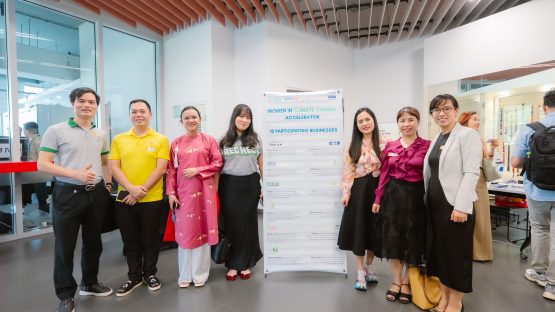Vietnam has 17% women-owned businesses and 27% women-led businesses, yet a staggering 97.2% of them (73.9% micro and 23.3% small) have yet to scale up. Previous studies have pointed out numerous barriers for women entrepreneurs, ranging from gender bias, family and societal expectations, to obstacles in accessing finance, markets, and the digital divide… For many years, various stakeholders have made efforts to promote the development of women entrepreneurs and women-owned/led enterprises, especially micro and small enterprises (WSMEs).
The report “Supporting Women Entrepreneurs in Vietnam: An Ecosystem Perspective” by WISE, conducted from late 2024 to mid-2025, delves into analyzing four pillars (Government, Financial Institutions, Business Support Organizations – BSOs, and Donors). It thereby provides a comprehensive overview of the current situation, challenges, and opportunities for ecosystem partners to collaborate towards the sustainable development of this group of enterprises.
Ecosystem highlight: Gender mainstreaming is becoming a key trend
The report shows the ecosystem is undergoing significant transformations. In terms of policy, gender equality is no longer just a statement of intent but has been integrated into key national legal frameworks such as the Law on SME Support, Decree 80/ND-CP, recent resolutions like Resolution 68-NQ/TW, 198/2025/QH15, and Project 939/QD-TTg.
In the financial sector, four commercial banks (VPBank, SeABank, TPBank, and HDBank) now offer specialized products for WSMEs. Additionally, on the investment side, the Beacon Fund focuses entirely on women, and four other funds apply the 2X Criteria.
Regarding the ecosystem, there are currently 3 key organizations (VWEC, WeLead, WISE) operating alongside dozens of associations, clubs, and networks for women entrepreneurs, as well as BSOs with gender-integrated initiatives and programs. This is coupled with sustained support from donors like DFAT, GAC… and large corporations such as Mastercard, Visa, and Unilever.
Finally, attention and support programs for WSMEs are significantly improving through national awards honoring women entrepreneurs, ecosystem-building efforts including an ecosystem map, the WeConnect connection platform, and many new initiatives.
All these changes indicate that gender is no longer a peripheral factor but is gradually becoming a crucial part of the programs and strategies of various organizations, including those in the business and financial sectors.
Ecosystem challenges
Despite progress, the ecosystem supporting women entrepreneurs faces numerous challenges. The report identifies fragmentation and a lack of coordination as a systemic challenge. Many initiatives exist but often operate in isolation, lacking a central coordinating body, leading to duplication of support and certain policy gaps.
Furthermore, key support organizations are small-scale with limited resources, dependent on short-term financing. This is particularly concerning as major donors are withdrawing, leaving financial gaps that domestic investment and private sector support cannot yet fill.
Moreover, banks, venture capital funds, and the private sector still lack sufficient motivation and readiness to adopt gender mainstreaming practices. Finally, the lack of gender-disaggregated data persists, making it difficult to monitor the effectiveness of gender programs and initiatives, while also failing to provide a solid basis for policy advocacy or persuading the private sector to act.
More than just a report, this is an “action map”
More importantly, the report highlights strong opportunities to boost women-led enterprises. New policies and programs, such as the law on individual household businesses and Project 939 Phase 2, are extending support to micro and rural women entrepreneurs. Concurrently, banks and investors increasingly recognize women as a potential customer segment. Finally, digital transformation and business-supply chain linkages are opening new doors for women’s enterprises to achieve sustainable growth.
To grasp the full picture and strategic recommendations for building a sustainable ecosystem, DOWNLOAD THE FULL REPORT at: LINK
1The 2X Criteria were developed under the 2X Challenge—a global initiative led by G7 development finance institutions—to mobilize capital that advances women’s economic empowerment. Investments qualify as 2X if they meet at least one of five criteria related to women’s ownership, leadership, quality employment, consumption, or participation in the value chain. These criteria serve as a practical framework for identifying gender-smart investments that contribute meaningfully to gender equality.




